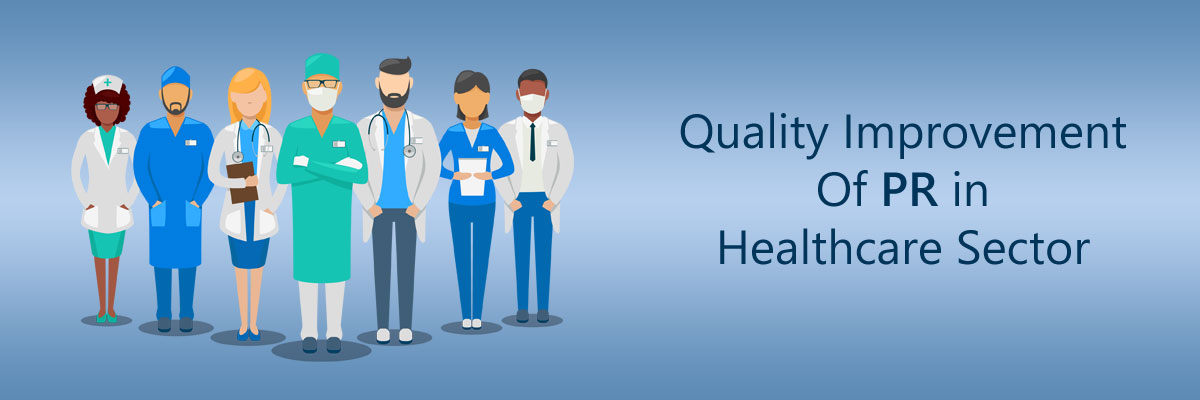Quality Improvement of PR in Healthcare Sector

Quality Improvement of PR in Healthcare Sector
The Healthcare sector and healthcare professionals in any country are the product of long-term actions and planning. Apart from weaknesses like lack of infrastructure, poor medical facilities, unskilled professionals, poor service quality, and unawareness of health issues most of the countries deal with the issue of lack of trust between patients and health service providers. PR agencies have the responsibility to create and maintain the goodwill of the healthcare sector within society. PR is supposed to aware people of the actions and inactions of health service providers. PR is said to be effective when it portrays a good image of health professionals and organizations to its public.
Need for Public Trust in the Healthcare Sector
When health facilities and literacy are increasing then building trust and maintaining it is the most difficult thing. Trust is the key indicator of patients’ satisfaction. The absence of trust affects health service providers and patients as well. If patients delay consultation with doctors, then this can show harmful effects on health. If people have trust in the healthcare system, then the sector has achieved competitive strength and it will be going to benefit it financially in the future. This will eventually benefit people by having positive physical outcomes.
Why Do not People Trust Healthcare?
Continuous failures in many ways have led to erosion of trust in the healthcare system. There are some causes listed down below that affect distrust in medical services using the cause-and-effect diagram.
Many such causes are yet to be resolved. The goal of the healthcare sector is to earn, build and maintain trust by addressing such issues before the healthcare system is completely eroded as it will be costly and difficult to build again.
Role of PR Agency to Build Trust about Healthcare among Public
While working within the healthcare sector it is very important to build internal and external communication to remain ahead of the competitor.
It is required to spread awareness about medical campaigns and other social work done by the hospital among people. People need to know what kind of facilities are available in a particular hospital. All these things can be handled by the PR person to build a brand image of a particular organization using specific skills. To enhance growth, PR can publish and write relevant things about their client to increase the reputation of the client within the public. Rules and regulations in certain fields of health are evolving, that is increasingly difficult to keep up with all the changes. The PR person or agency can be aware of this and would be able to offer guidance and accurate recommendations, as necessary.
DMAIC Process
- Define
It is needed to define the problem of the client and what value he needs to add to the public about his firm. Some hospitals have defined PR strategies that require process improvement; other hospitals do not have such requirements in place and need to develop processes as part of a new effective strategy. The relevant processes to be developed or improved should be determined in this first phase by defining the necessary requirements. For example, if any renowned healthcare trust wants to spread awareness about its medical campaigns, social work, medical facilities, and service quality this is the problem of the client in this case.
2. Measure
Having defined the requirements in the Define phase, at this stage attributes of target audiences are measured. The extent to which established processes effectively support the reputation of the company and its brand among audiences needs to be measured. Stakeholders or target audiences are the people who are the direct targets of the communication programs of a company. Consider a hospital where some of the patients perceive that their time consumed in taking tests and waiting is longer than other hospitals and they spread this on online platforms as reviews or blogs. The story could easily damage that business. Influence in communication means anyone that has a say in how people perceive a service or product and their responses to communication efforts must be measured. Writing innovative press releases without knowing who these releases are supposed to target in the first place is a wasteful exercise. Through the Measure phase, one can appropriately classify stakeholders so targeted communications can lead to a higher reputational impact. In healthcare sector mouth publicity plays the important role. Target audience not only include public but also current patients who will recommend the client to relatives and friends and other doctors which will recommend the client to his patients for further treatments. All these attributes and their relationships can be measured using matrix diagrams.
3. Analyse
At this stage clients’ current perceptions and position among people and the difference between what they desire and the reality of their position in the market is analysed. The challenges impacting the attainment of the performance level they need to reach can be analysed for root causes. Other tools and methods of analysis such as the 5 Whys can also be used in this stage of analysis. For example, if reputational messages are being developed, the 5 Whys application could be used to determine possible reasons why a message does not have the desired effect on target audiences. In the case of reputation, new messages may need to be developed which incorporate the priorities that the team decides the company needs to address as part of its communication strategy, and testing may need to be used on target audiences. Impact can also be determined by finding out focus group opinions through independent research and examining sources of public user opinion, e.g., forums, blogs, social network comments, and other media sources. To analyse the flow of systems and information value stream mapping technique can be used.
4. Improve
At this stage data and information should have emerged from previous phases which will highlight areas of communication tactics and messages which need new processes, or which can be improved. Process maps resulting from team analysis can help in making comparisons between old processes and new processes based on recommendations in the “Analyse” phase. In the case where entirely new processes are being developed with no baseline to compare them to, analysis with the existing processes of a competitor may be required before development. Implementation should be in pilot phases to compare the performances of the newly implemented processes and determine if a solution has been found that improves on the existing process. Internal and external aspects of the strategy will also need to be tweaked to improve the communications program.
5. Control
Benefits gained should be documented and maintained to not lose ground on areas of improvements. One key is reputational behaviour observed and feedback gained from external sources measured through means such as surveys, opinion gathering, social media monitoring, and other analytical methods. There should be frequent assessment for continuous improvement of existing processes which may work optimally in their current configuration but may require improvement if audience requirements and opinions change.
This approach can help ensure that a hospital builds a positive reputation in the eyes of target audience.
Final Words
Lean Six Sigma is a method for improving productivity, chance to create processes, measure, analyse, and improve quality while acknowledging the effectiveness and efficiency of a company’s communications strategy. The current media world is dynamic. Lean six sigma assists with fine-tuning strategies that ensure long-term viability and advancement, as well as assisting businesses in identifying and effectively interact with stakeholders. Communications Process Improvement expands on a stable platform by implementing the same elements of lean six sigma to secure advances and prepare for future improvements in a way that is relevant to target audiences. The healthcare industry has long connections in building affinity with the public through loyalty and service quality and when PR activities are added into it the health care industry can greatly benefit.

Blog Admin:
Ravinder Bharti
CEO & Founder - Public Media Solution
About: Ravinder Bharti is the Founder and CEO of Public Media Solution,
a leading
marketing, PR, and branding company based in India.